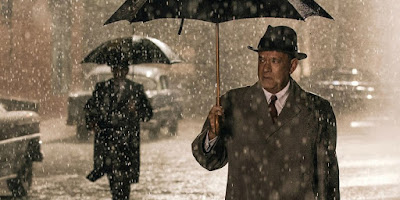★★★★
Viewers have to grant Crimson Peak its givens. The film’s an anachronistic project with its heart in late 19th century gothic romance. It’s not ironic about the genre conventions, and it doesn’t try to overly update them. Instead, it respects the form and integrates del Toro’s unique visual talents into a sumptuous cinematic use of the style. Vieweres have to be willing to buy into the genre and into del Toro’s vision, but Crimson Peak is a great experience for those who can.
Allerdale Hall, aka Crimson Peak, is the most obvious gothic element here. It’s a grand, decaying mansion full of gothic arches, stairways and halls. The ceiling has given way in the main room, so we see the rich interiors with rain or snow filtering into the frame. Black, wispy ghosts lurch into the frame on occasion, and every available space on the screen seems to be filled with splendid, baroque fabric or Victorian exotica. A unique del Toro contribution here is the red ooze that leeches from the house: it flows down walls and runs through pipes. When characters walk through snow, their footprints turn red behind them the way snow turns to clear slush behind the rest of us. The film explains that this color comes from the unique red clay that underlies the mansion.
The characters likewise come from the gothic world. There’s a blonde, romantic heroine who wants to write about ghosts, and a disturbing brother and sister who have an unhealthy though unclear relationship. A protective father and a rescuer boyfriend round out the cast of characters. And the actions of these characters are appropriately melodramatic. The father is killed when he discovers important information about the Sharpe siblings, though his gory death is a special del Toro touch. Thomas Sharpe begins his affair with Edith to get her money, though he sincerely falls in love with her and must sacrifice himself to save her. And the final conflict between Edith and Lucille Sharpe is high drama as Lucille runs down stairs with her dress billowing behind; here again, there are evident del Toro contributions to the gothic showdown.
As much as del Toro brings his own sensibility to the gothic in Crimson Peak, this film is still a literary-like delight. And it’s as lean and cohesive as any 19th century novel, and a good deal moreso than many films. Crimson Peak invites its viewers to enjoy the gothic and del Toro and to sit back and savor very rich visuals.
Viewers have to grant Crimson Peak its givens. The film’s an anachronistic project with its heart in late 19th century gothic romance. It’s not ironic about the genre conventions, and it doesn’t try to overly update them. Instead, it respects the form and integrates del Toro’s unique visual talents into a sumptuous cinematic use of the style. Vieweres have to be willing to buy into the genre and into del Toro’s vision, but Crimson Peak is a great experience for those who can.
Allerdale Hall, aka Crimson Peak, is the most obvious gothic element here. It’s a grand, decaying mansion full of gothic arches, stairways and halls. The ceiling has given way in the main room, so we see the rich interiors with rain or snow filtering into the frame. Black, wispy ghosts lurch into the frame on occasion, and every available space on the screen seems to be filled with splendid, baroque fabric or Victorian exotica. A unique del Toro contribution here is the red ooze that leeches from the house: it flows down walls and runs through pipes. When characters walk through snow, their footprints turn red behind them the way snow turns to clear slush behind the rest of us. The film explains that this color comes from the unique red clay that underlies the mansion.
The characters likewise come from the gothic world. There’s a blonde, romantic heroine who wants to write about ghosts, and a disturbing brother and sister who have an unhealthy though unclear relationship. A protective father and a rescuer boyfriend round out the cast of characters. And the actions of these characters are appropriately melodramatic. The father is killed when he discovers important information about the Sharpe siblings, though his gory death is a special del Toro touch. Thomas Sharpe begins his affair with Edith to get her money, though he sincerely falls in love with her and must sacrifice himself to save her. And the final conflict between Edith and Lucille Sharpe is high drama as Lucille runs down stairs with her dress billowing behind; here again, there are evident del Toro contributions to the gothic showdown.
As much as del Toro brings his own sensibility to the gothic in Crimson Peak, this film is still a literary-like delight. And it’s as lean and cohesive as any 19th century novel, and a good deal moreso than many films. Crimson Peak invites its viewers to enjoy the gothic and del Toro and to sit back and savor very rich visuals.









